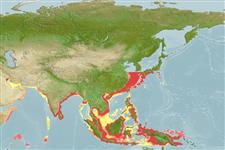Common names from other countries
Environment: milieu / climate zone / depth range / distribution range
Ecología
; rango de profundidad 0 - 175 m (Ref. 109). Tropical; 34°N - 10°S, 48°E - 155°E
Indo-West Pacific: from Persian Gulf to India, east to Papua New Guinea, and north to Japan and China. Introduced in the Mediterranean.
Length at first maturity / Tamaño / Peso / Age
Maturity: Lm 8.6, range 6 - 6.5 cm Max length : 12.9 cm TL macho / no sexado; (Ref. 409); 14 cm TL (female)
Maximum body length: 9.0 cm (male); 14.0 cm (female); common body length between 6.0 to 8.0 cm (Ref. 409). Maximum total length (male) from Ref. 119750. Common length range: 6.5 to 10.9 cm, male. Common weight range: 3.7 to 13.5 cm, male (Ref. 76922). Maximum depth from Ref. 409. Juveniles inhabit subtidal edge of mud flats, near inshore and far inshore waters (Ref. 121464). On muddy bottoms close to the shore, up to a depth of 85 m (Ref. 801). Also found near mouth areas of estuaries (Ref. 106567). Burrows in mud during the day time, with only the tube-like antennular flagella sticking out for respiration (Ref. 409).
Mating behavior: Precopulatory courtship ritual is common (through olfactory and tactile cues); usually indirect sperm transfer (Ref. 833).
Holthuis, L.B. 1980. (Ref. 8)
IUCN Red List Status (Ref. 130435)
CITES status (Ref. 108899)
Not Evaluated
Not Evaluated
Human uses
Pesquerías: comercial
| FishSource | Sea Around Us
Herramientas
Fuentes de Internet
Estimates based on models
Preferred temperature
(Ref.
115969): 13.8 - 29.1, mean 27.8 (based on 2170 cells).
Resiliencia
Alto, población duplicada en un tiempo mínimo inferior a 15 meses (K=1.18-2).
Vulnerability
Low vulnerability (10 of 100).
Price category
Unknown.
